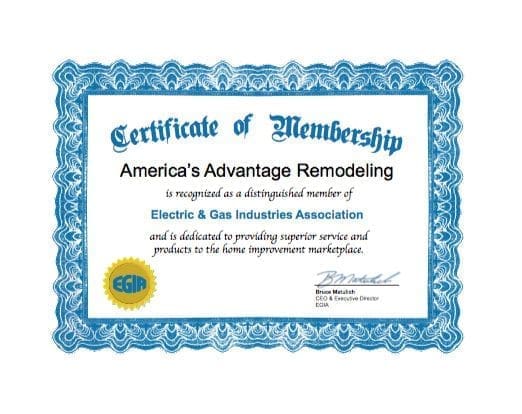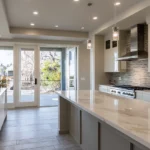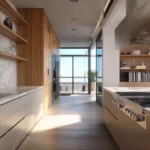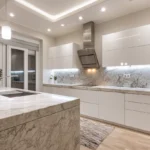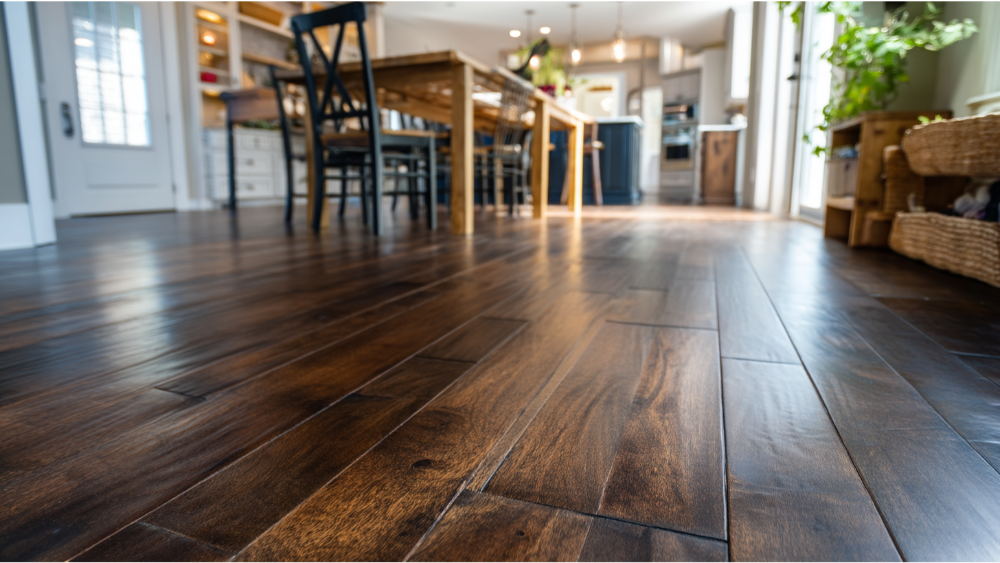
Hardwood floors add warmth, value, and elegance to your kitchen. Learning how to clean hardwood floors the right way will help you preserve their beauty for years. With proper maintenance, wood floors stand up to spills, foot traffic, and everyday life in your house. If you want to clean wood floors without causing damage, avoid excessive water, steam cleaners, abrasive cleaners, harsh chemicals, and the wrong tools. This guide will teach you how to clean hardwood floors step by step with a microfiber mop, the right cleaning solution, and elbow grease so you can maintain your kitchen floors like a pro.
Why Kitchen Hardwood Floors Require Special Care
Kitchens, Moisture, and Heavy Use
Kitchen hardwood floors see constant spills, grease, dust, and hot water from cooking. High foot traffic from shoes, children, pets, and guests stresses wood grain and finish. Even high humidity from cooking can lead to excessive water in wood pores. Learning how to clean hardwood floors means keeping moisture controlled and dealing with dirt quickly.
Consequences of Improper Cleaning
Even a single use of steam cleaners on wood floors, or using a wet mop with too much water, can cause warping or buckling over time. Abrasive cleaners, white vinegar solutions, dishwashing liquid with strong chemicals, or chlorine bleach can dull the finish or strip protective coatings. Harsh chemicals and wax buildup invite dust and dirt that erodes hardwood with every step. For proper maintenance of kitchen hardwood floors, you need the right cleaning product, tools, and technique.
Sealed Versus Unsealed Floors
Sealed wood floors have a polyurethane coating that protects the wood. A quick test is to place a few drops of water on the floor. If the water beads, you have sealed floors. If it soaks in over long periods, it is unsealed. You must use different cleaning methods depending on seal status. This guide assumes sealed hardwood floors, which are easier to clean and maintain without damage.
Step‑by‑Step Guide to Clean Hardwood Floors
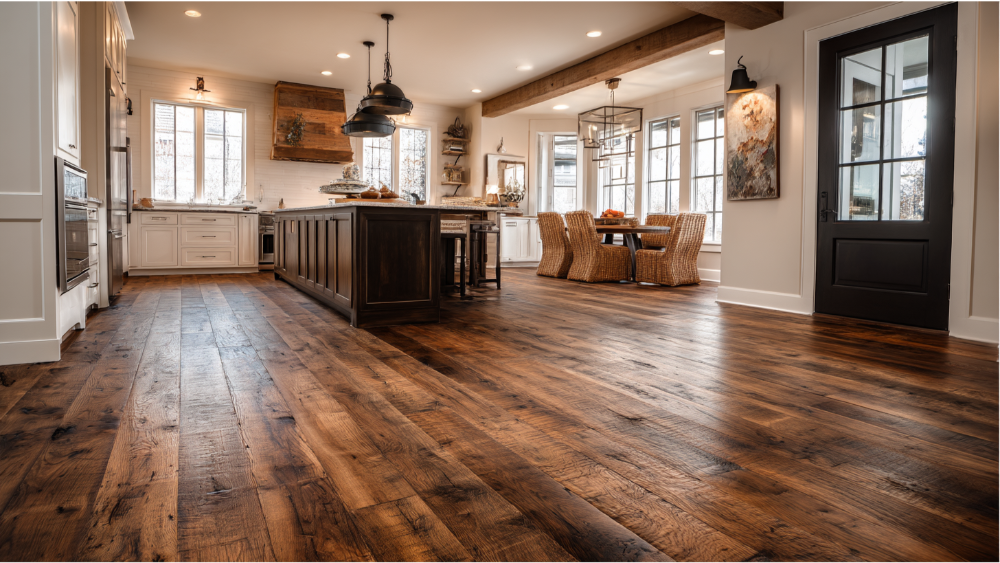
Step 1 – Sweep, Dust Mop, and Vacuum Regularly
Start by removing loose debris and dirt. Use a soft cloth broom or a dedicated dust mop daily. Vacuuming once or twice a week with a hardwood‑safe vacuum head will prevent sand‑like grit from scuffing the finish. Don’t skip this step, because cleaning wood floors with dirt still there causes scratches, dull spots, and premature wear.
Step 2 – Weekly Damp Mop for Clean Hardwood Floors
A damp mop with a microfiber mop head is the best tool to clean wood floors. Do not use a wet mop, bucket of water, or steam cleaners. Instead, fill a bucket with warm water and a few drops of water‑based cleaning solution or wood floor cleaner. Dip the mop, wring it thoroughly so it’s damp, then mop following the wood grain to prevent streaking. Make sure excess water is squeezed out before use. After mopping, go over the floor again with a dry mop or microfiber cloth to air dry the surface completely. This routine avoids excessive water exposure while cleaning wood floors thoroughly.
Step 3 – Spot Clean Spills Immediately
Kitchen spills happen often. Always keep a pack of paper towel or damp paper towel on hand. Blot a spill right away instead of wiping, because wiping can smear liquids deeper into finish. Use warm water with a drop of dish soap or dishwashing liquid to clean sticky or greasy messes. Rinse with a damp soft cloth and dry thoroughly. For stubborn stains, use a cleaning product designed for hardwood floors, applied sparingly with a damp mop head or soft cloth. Wipe, rinse, and dry completely to prevent damage.
Step 4 – Monthly Deep Cleaning Session
Each month, give your hardwood floors a deeper clean. Use a specialized wood floor cleaner in the recommended dilution. Scoop a small amount into warm water, dip microfiber mop head, wring until just damp, mop with wood grain, then rinse the mop head as needed. Finally, use a dry mop or soft cloth to remove any moisture. Air dry for a few minutes. This deep clean removes stuck‑on residues, grease, and dirt that regular mopping misses. If buildup remains, call in professional hardwood cleaning to restore shine.
What Not to Do When Cleaning Wood Floors
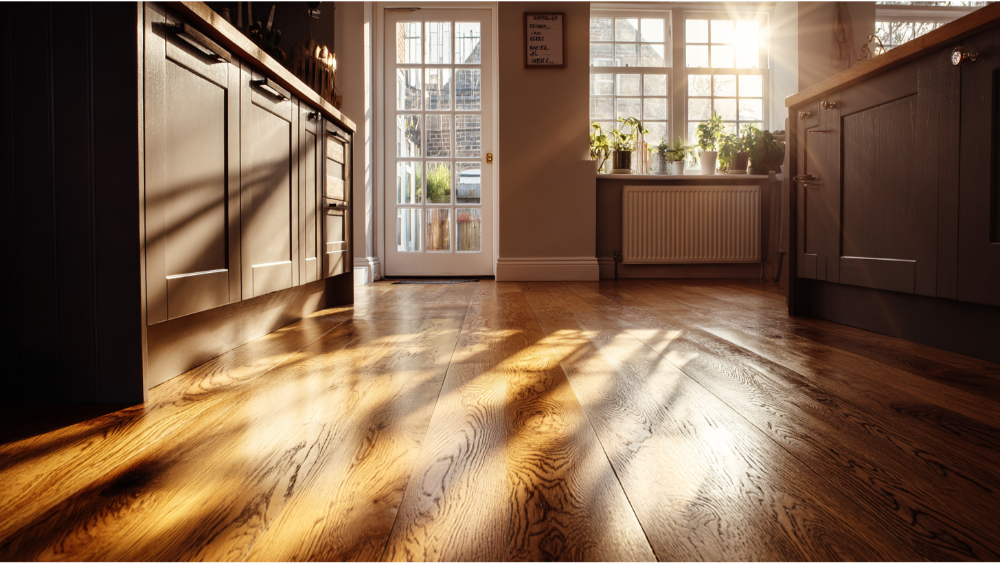
Avoid Wet Mops and Excessive Water
Never use wet mop or bucket after bucket with hot water on wood floors. Excessive water leads to cupping, warping, and discoloration. Always wring the mop thoroughly before use and follow up with dry mop to keep floors dry.
No Steam Cleaners or Abrasive Cleaners
Steam cleaners introduce heat and moisture that can warp wood. Abrasive cleaners scratch finishes and dull the surface. Avoid harsh chemicals, chlorine bleach, white vinegar, and pine oil on hardwood floors. They can break down finishes and leave residue that attracts dirt.
Skip Wax, Oil-Based Polishes, and Paper Towels Alone
Wax leaves buildup, becomes slippery, and creates uneven shine. Oil‑based products, like olive oil mixes, attract dust and leave greasy residue. A paper towel alone or dry mop with dust still there just spreads dirt. After cleaning with a damp mop, always go over with a dry mop to prevent haze and streaking.
Don’t Forget Protection and Maintenance Between Cleanings
To maintain hardwood floors, fit felt pads to chair legs and table legs to prevent scratches from shifting furniture. Place rugs or mats near the door, sink, and stove to catch spills and dirt. Trim pet nails regularly. Control indoor humidity levels to avoid expanding or shrinking wood, which causes cracks or gaps. These habits go beyond cleaning—they are essential proper maintenance practices for lasting beauty.
Long‑Term Maintenance Tips for Clean Wood Floors
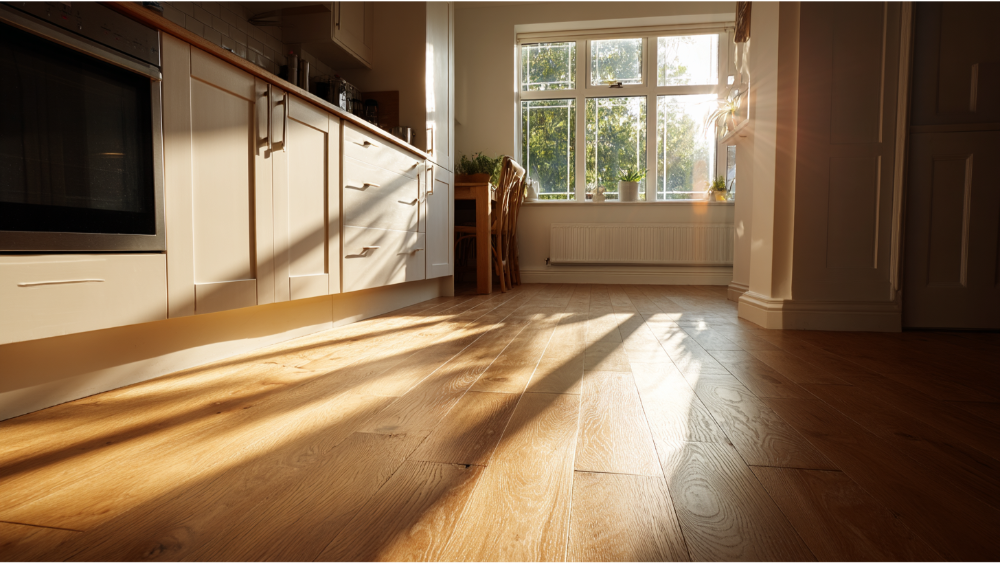
Use Area Rugs and Mats Strategically
Place mats in high‑risk areas where spills and moisture are common. Mats protect floors from grease, dirt, hot water spills, and foot traffic. Make sure mats have non‑abrasive backing so they don’t scratch the finish. Clean them regularly to avoid dirt accumulation beneath them.
Apply Felt Pads to Furniture Legs
Felt pads are inexpensive, easy to install, and highly effective at preventing scratches when chairs and tables move. Check them every few months and replace them when worn.
Maintain Ideal Indoor Humidity
Keeping indoor humidity between 35 and 55 percent minimizes wood expansion and contraction. Use a humidifier in winter and dehumidifier in summer, especially in multi‑season climates. This prevents cracking, warping, and separation along wood grain.
Recoat or Refinish Floors Periodically
Every 3 to 5 years, consider a professional recoat to refresh the finish without sanding. When wear and scratches deepen, a full refinishing with sanding and resealing may be needed every 7 to 10 years. This maintains durability and appearance through long periods of wear and tear.
Best Cleaning Solutions and Products
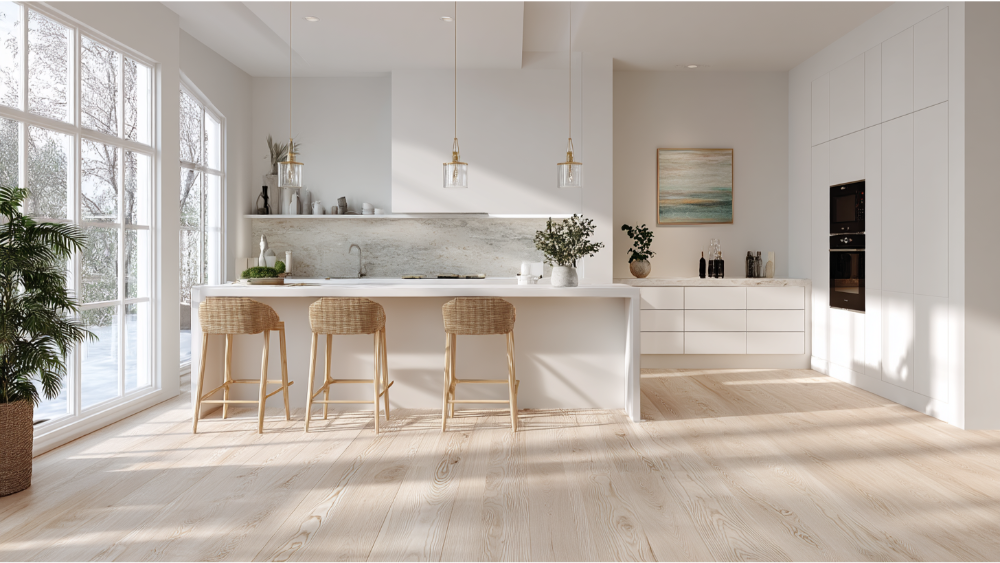
Recommended Floor Cleaners for Hardwood Floors
- Bona Hardwood Floor Cleaner is a trusted option for daily damp mop cleaning, and prevents buildup.
- Bruce Hardwood & Laminate Cleaner suits homes with pets or heavy foot traffic because it’s gentle but effective.
- Rejuvenate Professional Wood Floor Restorer can help revive a dull finish between recoats.
Use these products according to label instructions, and always test on a small area before full use.
DIY Cleaning Solution for Clean Hardwood Floors
A DIY cleaner can work if you need a quick solution. Mix warm water with a few drops of dish soap or dishwashing liquid in a bucket. Dip mop head or soft cloth, wring until damp and mop wood floors with the grain. Rinse mop head frequently and wipe with a dry mop. Use sparingly and only occasionally to avoid buildup. Never substitute DIY cleaners often, because they can alter finish over long periods.
Frequently Asked Cleaning Hardwood Floors Questions
Can I use steam cleaners on wood floors?
No. Steam cleaners add heat and excess moisture that can warp sealed wood, damage sealant, or cause cupping.
Should I avoid white vinegar for cleaning wood floors?
Yes. While vinegar is natural, it is acidic and may dull or damage finish over time. Stick to hardwood‑safe cleaners or mild DIY solutions.
How can I prevent streaking when damp mopping?
Use a microfiber mop head, wring it thoroughly, follow wood grain, and finish with a dry mop. Change water often and avoid hot water.
Is olive oil a good cleaner for wood floors?
No. Olive oil can build up, attract dust, and leave floors greasy. It might darken wood and create uneven shine.
How do I deal with stubborn stains?
Blot spills immediately with paper towel. Clean stubborn stains with hardwood cleaner, damp mop head or damp cloth and dry completely.
How often should I clean hardwood floors?
Dust mop or vacuum regularly, about three times a week. Damp mop weekly and deep clean monthly. Perform full maintenance every 3‑5 years or sooner in busy households.
Final Thoughts on Proper Maintenance for Wood Floors
Kitchen hardwood floors are a durable and attractive investment for your home when you know how to clean hardwood floors properly. Avoiding steam cleaners, abrasive cleaners, excessive water, harsh chemicals, wax, white vinegar, olive oil, and chlorine bleach will help maintain the protective seal. Use a microfiber mop head and the right cleaning solution to clean wood floors gently with wood grain. Always capture spills immediately with paper towel or damp paper towel, and finish by drying with a dry mop. Protect floors with rugs, felt pads, humidity control, and coat regularly. Following this routine will keep your floors looking like new through long periods of use.
If your floors are scratched, worn, or need refinishing, we can help. At America’s Advantage Remodeling, our kitchen remodeling services include expert hardwood floor restoration, recoating, refinishing, and sealing to maintain both beauty and durability. Visit our kitchen remodeling services page or contact us to schedule a free consultation.
CONTACT US
Our Services
Areas We Serve
Certificate
